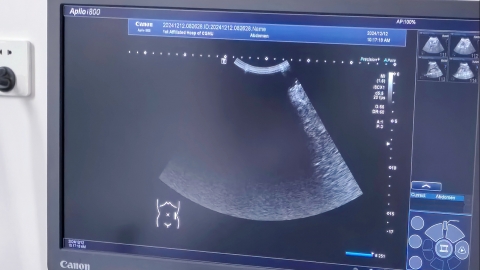What causes an empty gestational sac during pregnancy?
Generally, an empty gestational sac during pregnancy may be caused by factors such as short gestational duration, delayed implantation of the fertilized egg, luteal phase defect, chromosomal abnormalities, or abnormal uterine morphology. Symptomatic management may involve general treatment, medication, or surgical treatment. If discomfort occurs, prompt medical consultation is recommended. Detailed explanations are as follows:

1. Short gestational duration
If a pregnant woman has irregular menstrual cycles or a longer cycle length, the conception time may be short. During early pregnancy, ultrasound may only detect a gestational sac without visualization of the fetal pole or fetal heartbeat. This is a normal physiological phenomenon and does not require specific treatment. It is recommended that the pregnant woman undergoes a follow-up ultrasound one week later to monitor the development of the gestational sac.
2. Delayed implantation of the fertilized egg
The timing of implantation of the fertilized egg can be influenced by various factors, such as hormonal levels and endometrial condition in women. If the fertilized egg implants later than expected, ultrasound in early pregnancy might only show a gestational sac. Similarly, it is recommended that the pregnant woman undergoes a follow-up ultrasound one week later to confirm the development of the gestational sac. Meanwhile, maintaining a positive mental state and avoiding excessive anxiety are advised.
3. Luteal phase defect
Endocrine disorders or poor ovarian development may lead to luteal phase defect, which results in low progesterone levels. This may cause poor endometrial development, affecting normal implantation and embryonic development, ultimately leading to developmental arrest and an empty sac. The pregnant woman may experience periodic vaginal bleeding or irregular menstruation. It is recommended to follow medical advice and use medications such as dydrogesterone tablets, bromocriptine mesylate tablets, or progesterone capsules to support embryonic development.
4. Chromosomal abnormalities
If chromosomal abnormalities or polyploidy occur during early embryonic development, normal development is often not possible, leading to developmental arrest and an empty sac. During early pregnancy, the woman may not experience obvious abnormalities, or may have slight vaginal bleeding or abdominal pain. It is recommended to terminate the pregnancy via medical abortion (e.g., mifepristone tablets, misoprostol tablets) or surgical evacuation to avoid the risk of infection.
5. Abnormal uterine morphology
Uterine developmental abnormalities or conditions such as uterine fibroids or endometrial polyps may hinder normal implantation and development of the embryo, resulting in developmental arrest and an empty sac. The pregnant woman may experience recurrent miscarriages, infertility, or ectopic pregnancy. She may require hysteroscopic surgery or uterine reconstructive surgery to improve the uterine environment and increase the chances of a successful subsequent pregnancy.
Pregnant women should maintain healthy lifestyle habits and a positive mindset before and during pregnancy. Additionally, preconception checkups and regular prenatal examinations should be actively pursued to prevent the occurrence of an empty gestational sac.
References
[1] Zhao Lianwen, Guo Baofang. A retrospective study on serum β-HCG and progesterone levels in pregnant women with empty sacs in early pregnancy. Journal of Clinical Laboratory Science (Electronic Edition), 2018, 7(02): 177-178.
[2] Hou Shuxin. Application of ultrasound in diagnosing intrauterine embryonic developmental arrest. World Latest Medical Information Digest, 2015, 15(40): 29+31.




